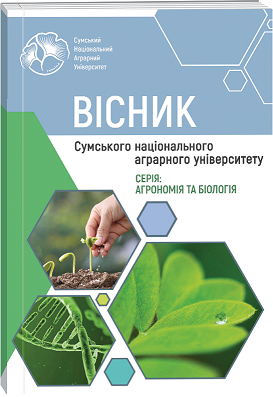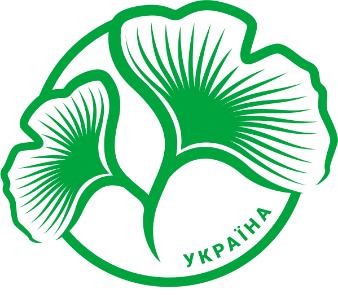MYCOBIOTA OF WINTER WHEAT (TRITICUM L.) SEEDS DEPENDING ON PROTECTIVE MEASURES
Abstract
The study aimed to investigate the interaction of winter wheat seed mycobiota with various protective systems, including chemical and organic, to improve winter wheat cultivation technologies. Particular attention was paid to establishing the relationship between the use of protective systems and changes in the seed mycobiota composition that affect wheat quality and yield. The research was conducted during 2022–2023 on two varieties of winter wheat: Aliot and Emil. Protective measures were taken at different stages of plant development. Pre-sowing treatment was carried out one day before sowing, and spraying was carried out at the stages of growth according to the BBCH scale (Biologische Bundesanstalt, Bundessortenamt und CHemische Industrie): 21–29 (tillering), 37–39 (flag leaf), and 71-77 (milky ripeness). The seed microbiota was analyzed using a biological method with potato glucose agar to detect external and internal infections. For the statistical analysis of the crop data, the Data Analysis tool in Microsoft Excel was used, in particular, the analysis method of variance, which allowed us to determine the influence of various factors on the study's results. The results of the study showed that the weight of 1000 seeds depended more on varietal characteristics than on the use of protective systems. However, it was found that the composition of the microbiota of winter wheat seeds significantly depends on the type of protection system used. In particular, the chemical protection system had the greatest impact on the microbiota composition. It was found that under the conditions of dominance of the fungus Alternaria tenuissima, the use of protective systems leads to a significant decrease in its number and changes in the composition of the fungal complex. At the same time, a significant spread of Penicillium spp. is associated with a significant slowdown in the growth of winter wheat seedlings and inhibition of other fungal species. It was also found that there is a moderate to significant correlation between the number of Fusarium oxysporum colonies and the weight of 1000 seeds. This indicates the negative impact of this fungus on seed filling, which is especially intensified under conditions that favor its development, in particular during favorable weather conditions. Based on the results of the study, the importance of controlling F. oxysporum populations to ensure high quality and yield of winter wheat was established. The results emphasize the need for further research to better understand the factors that influence the interaction between microbiota and defense systems, especially in the context of organic farming, which is considered a promising alternative to pesticides.
References
2. Bilousova, Z., Kenieva, V., & Klipakova, Y. (2020). Posivni yakosti nasinnya ozymoyi pshenytsi zalezhno vid komponentnoho skladu otruynykiv [Sowing quality of winter wheat seeds depending on the component composition of poisoners]. Ukrainian Black Sea Region Agrarian Science, 24(3), 79–86 (in Ukrainian). doi: 10.31521/2313-092X/2020-3(107)-10.
3. Eskola, M., Kos, G., Elliott, C. T., Hajšlová, J., Mayar, S., & Krska, R. (2020). Worldwide contamination of food-crops with mycotoxins: Validity of the widely cited ‘FAO estimate’ of 25%. Critical Reviews in Food Science and Nutrition, 60(16), 2773–2789. doi: 10.1080/10408398.2019.1658570.
4. Hawkins, N. J., Bass, C., Dixon, A., & Neve, P. (2019). The evolutionary origins of pesticide resistance. Biological Reviews, 94(1), 135–155. doi: 10.1111/brv.12440.
5. Khanzada, K. A., Rajput, M. A., Shah, G. S., Lodhi, A. M., & Mehboob, F. (2002). Effect of seed dressing fungicides for the control of seedborne mycoflora of wheat. Asian Journal of Plant Sciences, 1, 441–444. doi: 10.3923/ajps.2002.441.444.
6. Liu, Q., Liu, Y., Dong, F., Sallach, J. B., Wu, X., Liu, X., Xu, J., Zheng, Y., & Li, Y. (2021). Uptake kinetics and accumulation of pesticides in wheat (Triticum aestivum L.): Impact of chemical and plant properties. Environmental Pollution, 275, 116637. doi: 10.1016/j.envpol.2021.116637.
7. Mäder, P., Hahn, D., Dubois, D., Gunst, L., Alföldi, T., Bergmann, H., Oehme, M., Amadò, R., Schneider, H., Graf, U., Velimirov, A., Fließbach, A., & Niggli, U. (2007). Wheat quality in organic and conventional farming: results of a 21 year field experiment. Journal of the Science of Food and Agriculture, 87, 1826–1835. doi: 10.1002/jsfa.2866.
8. Narayanan, M., Kandasamy, S., He, Z., & Kumarasamy, S. (2022). Ecological impacts of pesticides on soil and water ecosystems and its natural degradation process. In P. Singh, S. Singh, & M. Sillanpää (Eds.), Pesticides in the Natural Environment (23–49). doi: 10.1016/B978-0-323-90489-6.00002-1.
9. Ons, L., Bylemans, D., Thevissen, K., & Cammue, B. P. A. (2020). Combining biocontrol agents with chemical fungicides for integrated plant fungal disease control. Microorganisms, 8(12), 1930. doi: 10.3390/microorganisms8121930.
10. Ostrovsky, D., Kornienko, L., Andriychuk, A., & Zotsenko, V. (2018). Mikromitsety zerna pshenytsi v Ukrayini [Micromycetes of wheat grain in Ukraine]. Scientific Journal of Veterinary Medicine, 1, 116–112 (in Ukrainian).
11. Prange, A., Modrow, H., Hormes, J., Krämer, J., & Köhler, P. (2005). Influence of mycotoxin producing fungi (Fusarium, Aspergillus, Penicillium) on gluten proteins during suboptimal storage of wheat after harvest and competitive interactions between field and storage fungi. Journal of Agricultural and Food Chemistry, 53(17), 6930–6938. doi: 10.1021/jf050821t.
12. Rozhkova, T. (2020). Vplyv vodnykh ekstrahtiv roslyn rodu allium na mikofloru nasinnya ta rozvytok parostkiv ozymoyi pshenytsi [The influence of aqueous extracts of Allium genus plants on the mycoflora of seeds and the development of winter wheat seedlings]. Ukrainian Black Sea Region Agrarian Science, 24(3), 53–61 (in Ukrainian). doi: 10.31521/2313-092X/2020-3(107)-7.
13. Rozhkova, T. O. (2022). Shkidlyvist Fusarium sp. z mikobioty nasinnya ozymoyi pshenytsi [Harmfulness of Fusarium sp. from mycobiota of winter wheat seeds]. Bulletin of Sumy National Agrarian University. The Series: Agronomy and Biology, 47(1), 119–124 (in Ukrainian). doi: 10.32845/agrobio.2022.1.16.
14. Rozhkova, T. O., & Spychak, Y. I. (2021). Regulirovanye mykoflory nasinnya ozymoyi pshenytsi obpryskamy fungitsydamy [Regulation of mycoflora of winter wheat seeds by spraying with fungicides]. Bulletin of Sumy National Agrarian University. The Series: Agronomy and Biology, 43(1), 42–48 (in Ukrainian). doi: 10.32845/agrobio.2021.1.6.
15. Schwartau, V., Mikhalska, L., Zozulya, O., & Sanin, O. (2019). Vplyv fungitsydnykh kompozytsiy na efektyvnist kontrolyu fuzariozu ta produktyvnist ozymoyi pshenytsi [The effect of fungicide compositions on the effectiveness of controlling Fusarium species and the productivity of winter wheat]. Quarantine and Plant Protection, 7–8(256), 23–28 (in Ukrainian).
16. Shevchuk, O., Golosna, L., Afanasieva, O., Zaslavskyi, O., Pryvedeniuk, N., & Kutsyk, T. (2021). Vplyv roslynnykh ekstraktiv na alternaria tenuissima (kunze) wiltshire in vitro [Effect of plant extracts against alternaria tenuissima (Kunze) Wiltshire in vitro]. Quarantine and Plant Protection, 4, 23–28 (in Ukrainian). doi: 10.36495/2312-0614.2021.4.23-28.
17. Spychak, Y. I., & Butenko, S. O. (2023). Vplyv systemy zakhystu na strukturu vrozhainosti ta yakist zerna pshenytsi ozymoyi na pivnichnomu skhodi ukrayiny [The influence of the protection system on the yield structure and grain quality of winter wheat in the north-east of Ukraine]. Bulletin of Sumy National Agrarian University. The Series: Agronomy and Biology, 51(1), 111–119 (in Ukrainian). doi: 10.32782/agrobio.2023.1.13.
18. State Register of Plant Varieties Suitable for Distribution in Ukraine. Ministry of Agrarian Policy and Food of Ukraine. [Online on: https://minagro.gov.ua/file-storage/reyestr-sortiv-roslin]. (Accessed on: 22.03.2024).
19. Syafrudin, M., Kristanti, R. A., Yuniarto, A., Hadibarata, T., Rhee, J., Al-onazi, W. A., Algarni, T. S., Almarri, A. H., & Al-Mohaimeed, A. M. (2021). Pesticides in drinking water–A review. International Journal of Environmental Research and Public Health, 18(2), 468. doi: 10.3390/ijerph18020468.
20. Thakur, M., Bhardwaj, N., Yadav, D., & Kadian, N. (2022). Impact of pesticide residues on soil microbiome and their degradation: A molecular approach. Applied Soil Ecology, 177, 104532. doi: 10.1016/j.apsoil.2022.104532.
21. Urban, M., Hammond-Kosack, K. E., & Kosack, P. (2020). The Fusarium graminearum genomic landscape: insights into the evolution of key pathogenic traits. Molecular Plant Pathology, 21(1), 1–16. doi: 10.1111/mpp.12864.
22. Walter, F., Rohde, M., Reichelt, M., & Döll, S. (2020). Fungicide resistance in Fusarium species causing Fusarium head blight of cereal crops. Agronomy, 10(5), 615. doi: 10.3390/agronomy10050615.
23. Xu, X. M., Nicholson, P., Thomsett, M. A., Simpson, D., Cooke, B. M., & Edwards, S. G. (2008). Relationship between the fungal complex causing Fusarium head blight of wheat and environmental conditions. Phytopathology, 98(2), 698–711. doi: 10.1094/PHYTO-98-0698.
24. Yigit, E., Dikilitas, M., Yildiz, H. N., & Karaboz, I. (2019). Application of biocontrol agents in wheat: Effectiveness against Fusarium head blight and plant growth promotion. Agriculture, 9(7), 147. doi: 10.3390/agriculture9070147.
25. You, M. P., & Barbetti, M. J. (2021). Understanding the biology of Fusarium oxysporum for sustainable agriculture. Plants, 10(3), 411. doi: 10.3390/plants10030411.
26. Zhukov, O. V., Rozhkova, T. O., & Spychak, Y. I. (2023). Kompleksna otsinka efektyvnosti zastosuvannya preparativ dlya obrobitku nasinnya pshenytsi ozyemoyi [Complex assessment of the effectiveness of seed treatment products for winter wheat]. Bulletin of Sumy National Agrarian University. The Series: Agronomy and Biology, 51(2), 131–139. doi: 10.32782/agrobio.2023.2.17.
27. Zimny, J., Sowa, S., & Dukat, P. (2018). Influence of fungicide treatments on yield, mycotoxin contamination, and Fusarium head blight severity in winter wheat. Plant Protection Science, 54(2), 99–108. doi: 10.17221/2/2018-PPS.
28. Zubair, M., Hamid, F., Ikram, M., Khan, F. A., & Latif, S. (2021). Evaluation of different fungicides and biocontrol agents against Fusarium species causing root rot of wheat in Pakistan. Journal of Plant Pathology, 103(3), 753–762. doi: 10.1007/s42161-021-00860-9.
29. Żurawicz, M., Węglarzy, K., & Skoczeń, K. (2022). Influence of biostimulants and fungicides on yield and quality of winter wheat grain. Agronomy Research, 20(1), 104–113. doi: 10.15159/AR.22.010.
30. Zwinger, S., & Mewis, I. (2019). Fusarium infection in wheat: Significance, causes, and control methods. Plant Pathology, 68(5), 795-803. doi: 10.1111/ppa.12968.

 ISSN
ISSN  ISSN
ISSN 



